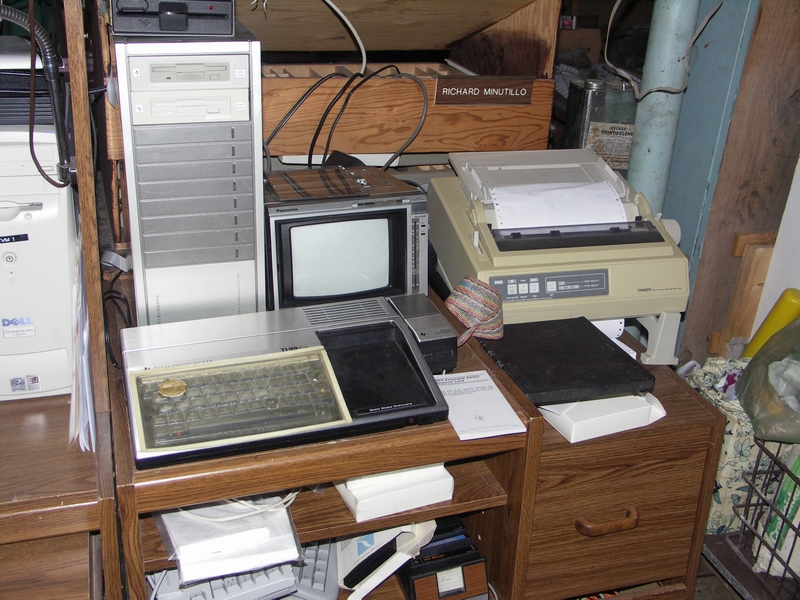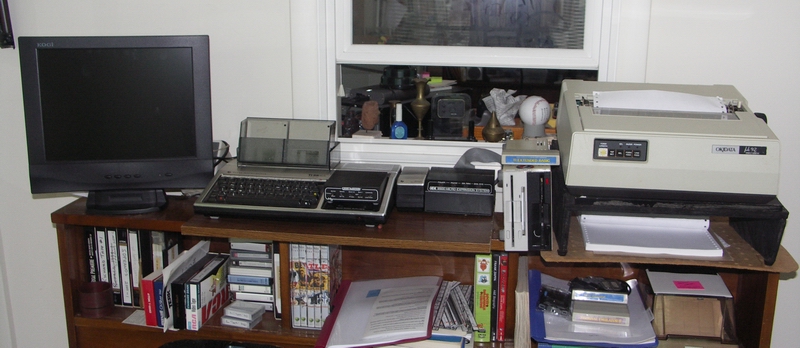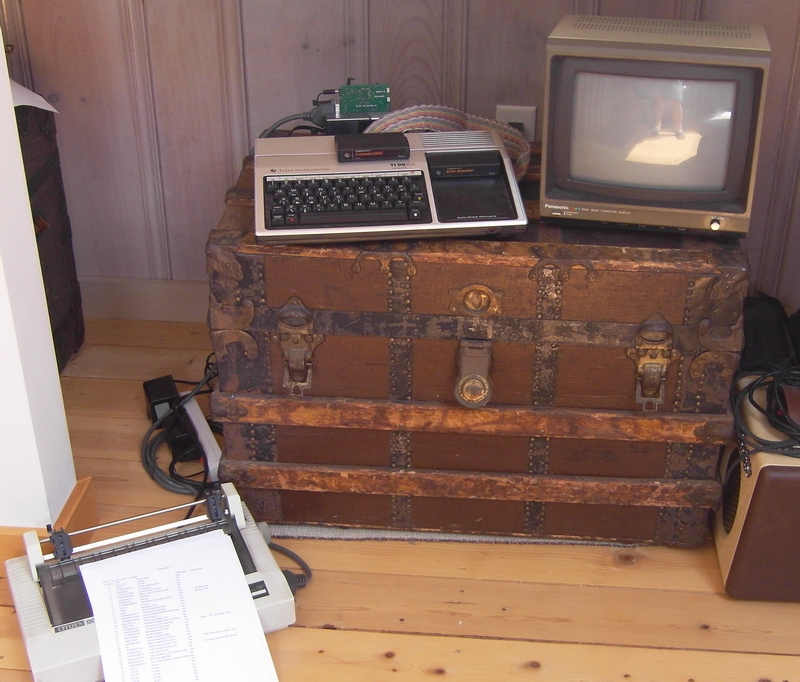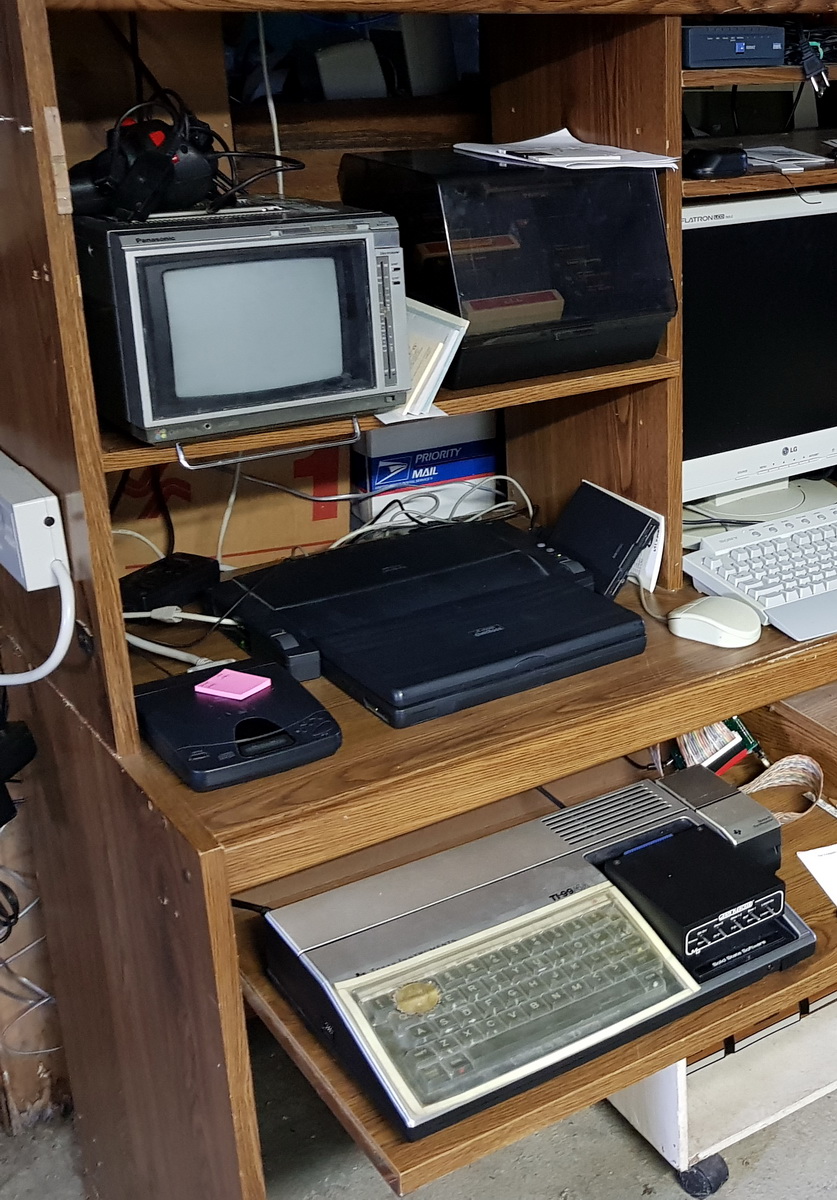The old system was an original black and silver console, speech synthesizer, and a cassette deck. I stuck with that setup for a while, eventually getting a Mini-Memory cartridge and learning assembly programming on that. The fully expanded system included a peripheral expansion box (PE box) with a modified fan. (I kept the beast in the bedroom, worked at it late at night, and I had to keep it quiet.) The PE box held a standard 32K memory card, standard RS232 card, and a CorComp floppy controller and two half-height DSDD capable 5 1/4" Shugart drives. The console eventually held an 80K Gram Kracker (an exotic device described very well here.) The printer was a rock-solid Okidata Microline 92, the joysticks some Atari clone joysticks I can't really remember which had to be connected through an adapter I still have, and a continuing succession of modems that went from 300 baud up to a speedy 2400 baud. (Never did have or use the acoustic coupler.) My first display was my TV, but I soon graduated to a small but excellent 7" TV/monitor with AV inputs, and finally graduated to the Panasonic branded version of the 10" color monitor. I still own and use both the 7" TV/monitor and the Panasonic, and both still work.
Eventually I migrated most of the stuff I could recover to 3 1/2" diskettes and some venerable 5 1/4" drives, and I obtained a new CF7+ drive attachment. I attached this stuff to a range of hardware in configurations that could change according to what I was up to. In most configurations these were better systems than the one I sold, although, of course, one could still do next to nothing with them that's actually productive. But it's about fun, not productivity. In any case, below are the three most typical configurations I used to keep around.
This combination usually included a speech synthesizer, peripheral expansion box with RS232, 32K memory, and a CorComp disk controller with upgraded eproms. The PE box has two 3.5" drives and drives two more 5 1/4" drives in an external enclosure. A Tandy dot-matrix printer with tractor feed worked pretty well on the printer port. No Gram Kracker in the main unit, but instead a couple of other third-party goodies I used to crave but never owned: an antique Horizon RAM Disk, and a newly build P-Gram+ (with clock.) At one point I had a p-Code card as well, which I thought would be neat but wasn't, so I sold it. I keep no modem on the system, but can make serial connections into with a nearby Linux system for a terminal session, or into a windows machine for capturing output. My old 7" TV/monitor is the primary display, because it fit best into my little basement computer rack. And speaking of fitting, that's a flexible ribbon cable that I use to attach the 'fire hose.'

This is a 'working' system, but it was down in the basement so not often in use. I didn't use the Gram Kracker in it because it didn't play nicely with the P-Gram+ card. That meant that I lost some the custom modifications I made to the TI's 'OS' through the GK, including my beloved modified character set. Nevertheless, the P-Gram+ provided the ability to load modified cartridges, like my ultimate modified Extended BASIC, and it had four banks of GROM/GRAM space instead of only one.
The RAM disk card was a nice addition because of it's ability to run a boot-up menu and hold some key utilities in battery-backed RAM, but it was old and the connections to it's NiMH rechargeable batteries were not so good. I liked it, though.
This main system is shown as it was in my basement 'museum/data center' and had easy access to serial ports on multiple old systems.
This unit usually included my Gram Kracker (alas I only own one,) a speech synthesizer, and a CorComp 9900 Micro Expansion system, another device I had always coveted. The 9900 includes 32Kb memory expansion, RS232s ports and a (real) diskette controller all in one little box. I used the 9900 with a spare console and an external enclosure holding a 5.25" and a 3.5" disk drive. The GK in combination with the 9900 was the closest match for my original system, and much quieter and more compact.
To complete the match with my original system was an Okidata 92 printer, actually a composite of two that I found. The first one had an excellent print-head and self-tested wonderfully, but the interface board was apparently shot, and I could not get it to print with any combination of cables/computers. Believe me, I tried, because this unit had the OKI ROMS and would have recognized all the control codes in my old software. When the second one came along I snatched it up. It was an 'IBM' OKI, with a normal parallel interface (which worked!) and IBM escape codes in the ROMS. It also had a terrible, worn-out printhead. So I swapped in the nice print head from the first printer, and also reserved those OKI ROMS which, someday, I thought I might try with the IBM interface board. (I never did!) In the meantime it was a solid printer, looked great, and worked with the OKI-IBM escape codes.

The video on this system was run through a composite to VGA converter (the cheapest I could find on eBay) and into a KOGI LCD VGA monitor. Worked quite nicely. I kept all this in a little sunroom adjacent to my office, and used it quite a bit... or at least more often than the big system in the cellar.
Finally there wasa console I used to keep in my summer house. It had a Speech Synthesizer and a CF7a device attached via another flexible ribbon cable, as well as my old 10" Panasonic/TI monitor. The new CF7A+ system included 32K memory and a parallel port. The CF7A+, hand built one at a time by Jaime Malilong, emulated memory expansion, added a parallel port for printing, and provided 'disk access' to diskette image files which are in turn stored on a handy CF card. No floppies. To print I had a solid old Citizen's 9-pin.

Since this was intended (at least partially) to be a game machine, I kept one of my Epyx 500XJ joysticks with it for 'serious' game-playing. I kept the other Epyx at home along with some TI joysticks, and yes, I still own a cassette recorder and the dual cassette cable. Don't use 'em, though.
My main goal in recreating my TI system was to recover software. Having done that (and facing increasing unreliability with the old equipment, especially diskettes) I sold off most of the hardware I had accumulated, keeping only enough for a skinny little system now in my basement. I fire it up every once in a while just to make sure all the pieces work.
This system consists of a fairly clean console, by Gram Kracker, a speech synthesizer, CF7+ , and my trusty old 7" monitor. No more physical drives, which were always more trouble than they were worth. Although I still own the Citizen printer, it is kept on a shelf and never used. And I still keep that Epyx joystick around, for the occasional bout of Parsec.
It all fits nicely into my basement antique computer desk, below a nifty antique HP 800CT portable with expansion box (and networking capability,) which runs my old Windows 3.11 and Windows 95 setups, and a modern NUC type linux system (not in this view) which actually runs my network.

I'd like another 80K Gram-Kracker, because I'd like to... have another one. If the one I have breaks, I'm doomed. And since I do have one more console left, I might buy another CF7+ device (if I could find one) or one of the newer 'NanoPEB' devices, which has a serial port instead of a parallel port. Probably won't do either.